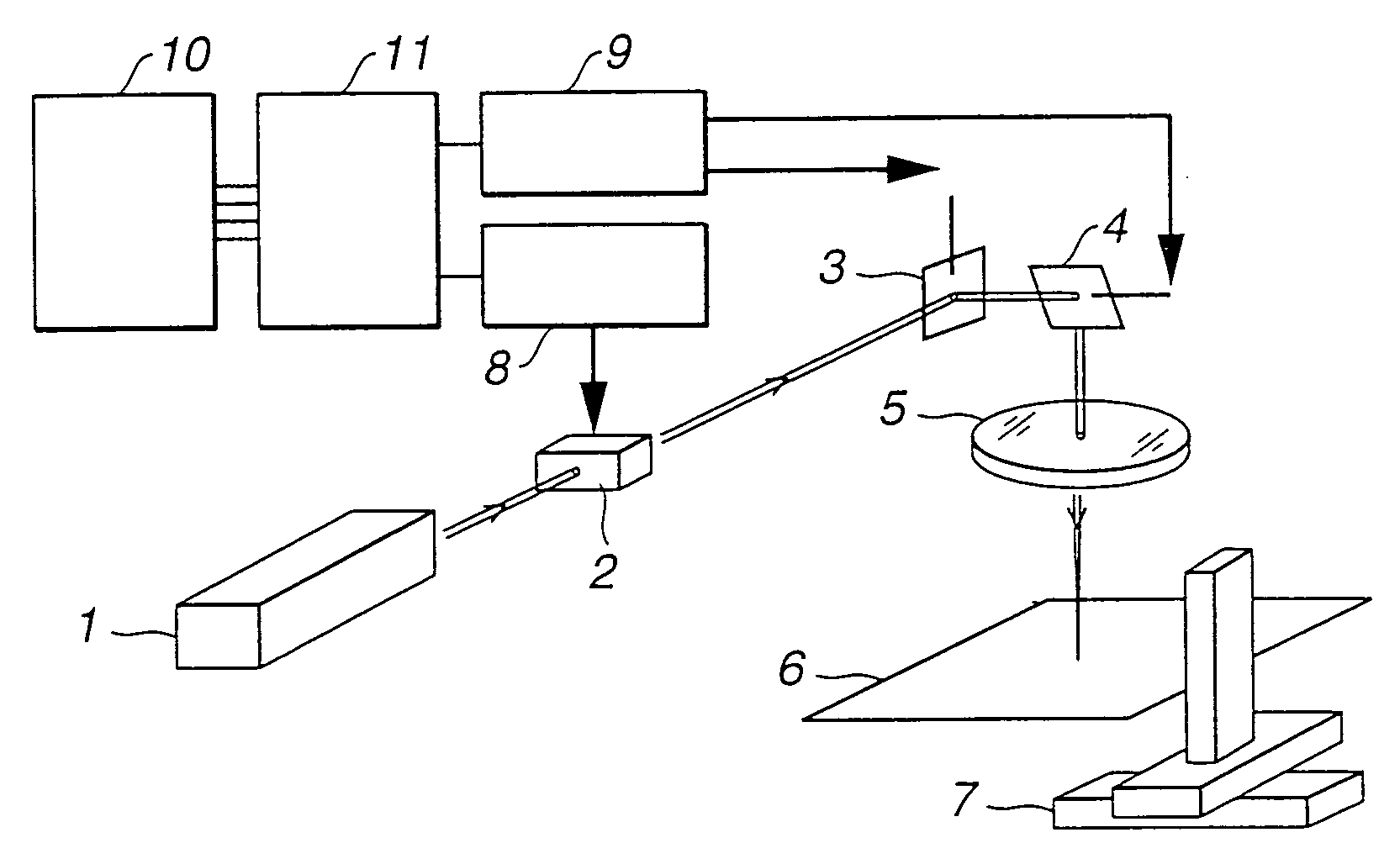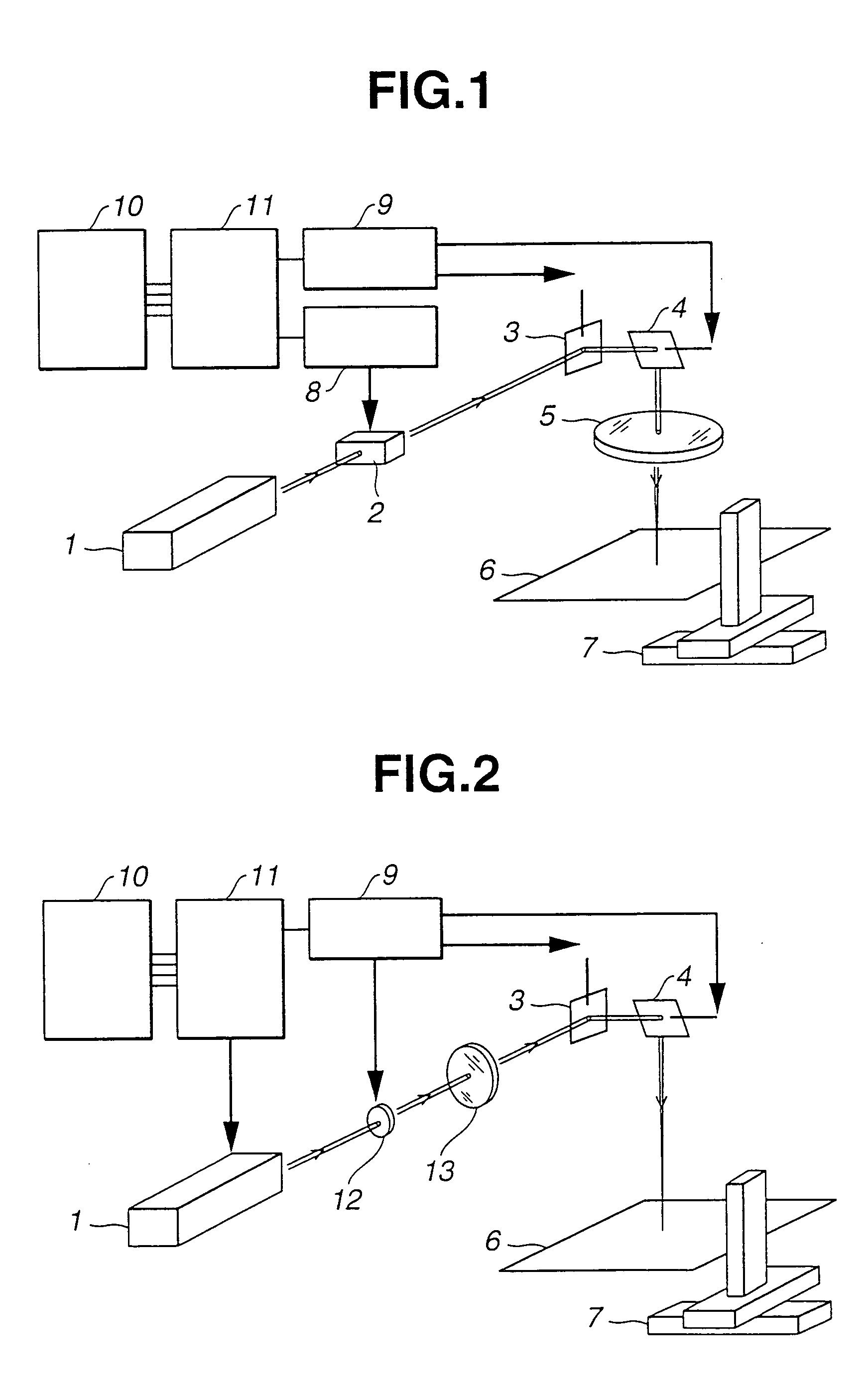Method for putting color to glass or erasing color from colored glass
a technology of colored glass and color, applied in the field of putting color to glass or erasing color from colored glass, can solve the problems of difficult to precisely regulate the focal point of laser light along the depth of the transparent substrate, the object is limited to a transparent material, and the object has cracks
- Summary
- Abstract
- Description
- Claims
- Application Information
AI Technical Summary
Benefits of technology
Problems solved by technology
Method used
Image
Examples
example 1
[0066] The second laser irradiation apparatus (shown in FIG. 2) was used for putting a color to a silicate glass containing non-bridging oxygen in its structure. A laser light was oscillated by the UV pulsed laser oscillator 1 to have a wavelength of 355 nm, a pulse width of 20 ns, a pulse energy of 117 μJ, an average output of 2.9W, and a repetition frequency of 25 kHz. This laser light was condensed by the condenser lens 2 into a laser beam, and this laser beam was reflected by the X-mirror 3 and the Y-mirror 4 toward the target 6. The target 6 was a transparent silicate glass plate having a thickness of 6 mm and widths of 100 mm and having a chemical composition of 72 wt % SiO2, 16 wt % Na2O, 10 wt % CaO, and 2 wt % Al2O3. The silicate glass plate was scanned with the laser beam with a scanning speed of 250 mm / sec.
[0067] The scanning was conducted by suitably switching on and off the Q switch built in the UV pulsed laser oscillator, by regulating the angles of the X-mirror 3 and...
example 2
[0072] The second laser irradiation apparatus (shown in FIG. 2) was used for putting a color to a silver-ion-containing glass. A laser light was oscillated by the carbon-dioxide laser oscillator 1 to have a wavelength of 10600 nm, a repetition frequency of 10 kHz or 20 kHz, and an average output of 1W, 2W, 5W, 10W or 20W. This laser light was condensed by the condenser lens 12 into a laser beam, and this laser beam was reflected by the X-mirror 3 and the Y-mirror 4 toward the target 6.
[0073] The target 6 was prepared as follows. At first, there was prepared by float method a soda-lime glass substrate (thickness: 5 mm; widths: 100 mm) having a chemical composition of 72 wt % SiO2, 16 wt % Na2O, 10 wt % CaO, and 2 wt % Al2O3. Then, the glass substrate was immersed for 5 min or 15 min in a fused salt (prepared by mixing 1 part by mol of AgNO3 with 4 parts by mol of NaNO3) heated at 590K (317° C.), thereby replacing Na ions of the glass surface with silver ions.
[0074] The target 6 (si...
example 3
[0080] The second laser irradiation apparatus (shown in FIG. 2) was used for putting a color to a silver-ion-containing glass. A laser light was oscillated by the UV pulsed laser oscillator 1 to have a wavelength of 355 nm, a pulse width of 20 ns, a pulse energy of 80 μJ, an average output of 2W, and a repetition frequency of 25 kHz. This laser light was condensed by the condenser lens 12 into a laser beam, and this laser beam was reflected by the X-mirror 3 and the Y-mirror 4 toward the target 6.
[0081] The target 6 was prepared in the same manner as that of Example 2, except in that the immersion was conducted for 1 hr.
[0082] The target 6 (silver-ion-containing glass) was scanned with the laser light to have a line width of 10 μm with a scanning speed of 250 mm / s, thereby drawing a rectangle (dimensions: 9 mm×15 mm) of a yellow color.
[0083] It was possible to draw a plurality of rectangles at a constant interval by horizontally moving the XYZ-stage 7.
[0084] Furthermore, it is p...
PUM
| Property | Measurement | Unit |
|---|---|---|
| wavelength | aaaaa | aaaaa |
| distance | aaaaa | aaaaa |
| wavelength | aaaaa | aaaaa |
Abstract
Description
Claims
Application Information
 Login to View More
Login to View More - R&D
- Intellectual Property
- Life Sciences
- Materials
- Tech Scout
- Unparalleled Data Quality
- Higher Quality Content
- 60% Fewer Hallucinations
Browse by: Latest US Patents, China's latest patents, Technical Efficacy Thesaurus, Application Domain, Technology Topic, Popular Technical Reports.
© 2025 PatSnap. All rights reserved.Legal|Privacy policy|Modern Slavery Act Transparency Statement|Sitemap|About US| Contact US: help@patsnap.com



